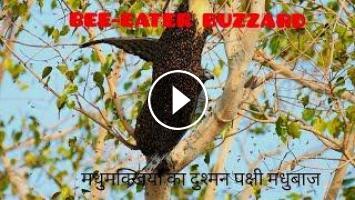The crested honey buzzard is a bird of prey in the family Accipitridae, which also includes many other diurnal raptors such as kites, eagles, and harriers. This species is also known as the Oriental honey buzzard. It is a widespread polytypic species with six subspecies including five largely sedentary subspecies occurring in the Philippines (philippensis, palawanensis), Java (ptilorhynchus), Sumatra, Borneo, and the Malay Peninsula (torquatus), and mainland Asia including India (ruficollis), and one migratory subspecies (orientalis) which is a common winter visitor to the Philippines and Indonesia, where large numbers occur annually on Java and Bali. The bird is Polymorphic, with extremely variable plumage colour. It appears long-necked with a small head often seen soaring on flat wings. The head lacks a strong superciliary ridge, giving it a facial appearance very unlike a raptor. It has a long tail and a short head crest. It is brown above, and paler below. A dark throat stripe is present. An unusually small and slender head, long striped tail, broad wings, and well-striped underwings make this species fairly recognizable across a wide area. The name is derived from its diet which consists mainly of the larvae of bees and wasps extracted from honey combs. It feeds on other insects, e.g. crickets, flying termites and ants; occasionally vertebrates, including lizards, frogs, small mammals and birds. It is a large raptor of lowland and montane broadleaf and mixed forests, this species is well-known for its tendency to congregate in large flocks of up to thousands during migration. Northern populations of Russia, Siberia and Japan are migratory, arrives on breeding grounds in Siberia and Japan in May, leaves in Sept/Oct for winter up to march April to India, Indian subcontinent from SE Asia S to Indonesia, where migrants overlap with sedentary populations. Nests mainly in tall broad-leaved trees, but also in conifers and even coconut palms, sometimes at considerable height, up to 28 m above ground. Nest built in fork of tree, platform of twigs lined with green leaves and other light material, 40–45 cm wide, 20 cm deep in India, up to 80 cm wide, 25 cm deep in Siberia, built by both adults. Clutch is normally of two eggs, incubation is done by both adults for a period of 30–35 days, both also feed chicks, fledging period is 35–45 days, chicks are independence 5–8 weeks after fledging.
काईट , ईगल और हैरियर जैसे कई अन्य दैनिक रैप्टर की तरह क्रेस्टेड हनी बज़र्ड भी एक्सीपिट्रिडी (Accipitridae) परिवार का एक शिकारी पक्षी है। इस प्रजाति को ओरिएंटल हनी बज़र्ड के रूप में भी जाना जाता है। यह छह उप-प्रजातियों के साथ एक व्यापक बहुरूपी प्रजाति है, जिसमें फिलीपींस (फिलिपेंसिस, पलावेनेंसिस), जावा (पीटिलोरिन्चस), सुमात्रा, बोर्नियो और मलय प्रायद्वीप (टोरक्वेटस), और भारत सहित मुख्य भूमि एशिया (रूफिकोलिस) में पाई जाने वाली पांच स्थानबद्ध उप-प्रजातियां शामिल हैं। और एक प्रवासी उप-प्रजाति (ओरिएंटलिस) जो फिलीपींस और इंडोनेशिया के लिए एक सामान्य शीतकालीन प्रवासी आगंतुक है, जावा और बाली में सालाना बड़ी संख्या में आते हैं। पक्षी बहुरूपी है, जिसमें अलग अलग रंग के और रंग बदलने वाले पंख होते हैं। यह एक छोटे सिर के साथ लंबी गर्दन वाला होता है जिसे अक्सर सपाट फैलाए हुए पंखों पर उड़ते हुए देखा जाता है। सिर में एक मजबूत सुपरसिलिअरी रिज का अभाव होता है, जिससे यह अन्य शिकारी पक्षियों से अलग दिखाई देता है। इसकी एक लंबी पूंछ और सिर पर एक छोटी कलगी होती है। यह ऊपर से भूरा और नीचे हल्का पीले रंग का होता है। गले पर काली पट्टी मौजूद होती है। एक असामान्य रूप से छोटा और पतला सिर, लंबी धारीदार पूंछ, और स्पष्ट धारीदार पट्टियों वाले नीचे के पंख अंडरविंग्स इस प्रजाति को एक विस्तृत क्षेत्र में अलग पहचान करने हेतु सहायता करती है। इसका यह नाम इसके आहार से लिया गया है जिसमें मुख्य रूप से मधुमक्खियों और ततैया के छत्तों से लार्वा और शहद शामिल होते हैं। यह अन्य कीड़ों कहाँ भी भोजन करता है जैसे क्रिकेट, उड़ने वाले दीमक और चींटियां, कभी-कभी कशेरुक जंतु, जिनमें छिपकली, मेंढक, छोटे स्तनधारी और छोटे पक्षी भी शामिल हैं। यह तराई और बड़ी पत्ती वाले, पत्तेदार वृक्षों के मिश्रित जंगलों का एक बड़ा शिकारी पक्षी (रैप्टर) है, यह प्रजाति प्रवास के दौरान हजारों की संख्या तक के बड़े झुंडों में एकत्र होने की प्रवृत्ति के लिए प्रसिद्ध है। रूस, साइबेरिया और जापान की उत्तरी आबादी प्रवासी हैं, मई में साइबेरिया और जापान में प्रजनन करती हैं, सितंबर/अक्टूबर में सर्दियों के लिए मार्च अप्रैल तक भारत, दक्षिणी पूर्वी एशिया से इंडोनेशिया तक भारतीय उपमहाद्वीप, जहां प्रवासी प्रजाति स्थानीय प्रजाति आबादी के साथ मिल (ओवरलैप) जाते हैं। मुख्य रूप से लंबे चौड़े पत्तों वाले पेड़ों में, लेकिन शंकुधारी और यहां तक कि नारियल के पेड़ों में भी, कभी-कभी काफी ऊंचाई पर, जमीन से 28 मीटर तक की ऊँचाई तक पेड़ की डालियों के तिकोने मिलने वाले स्थानों में घोंसला बनाते हैं । भारत में घोंसला, हरी पत्तियों और अन्य हल्की सामग्री के साथ टहनियों का, 40-45 सेमी चौड़ा और 20 सेमी गहरा मंच होता है।
पर्निस पीटीलोरहाइन्चस
Pernis ptilorhynchus
Mostly silent, even in nesting season. Occasionally gives single high-pitched whistle described as “wheeeeew” and multi-syllable “peeee-u” or “whi-whee-uho”
काईट , ईगल और हैरियर जैसे कई अन्य दैनिक रैप्टर की तरह क्रेस्टेड हनी बज़र्ड भी एक्सीपिट्रिडी (Accipitridae) परिवार का एक शिकारी पक्षी है। इस प्रजाति को ओरिएंटल हनी बज़र्ड के रूप में भी जाना जाता है। यह छह उप-प्रजातियों के साथ एक व्यापक बहुरूपी प्रजाति है, जिसमें फिलीपींस (फिलिपेंसिस, पलावेनेंसिस), जावा (पीटिलोरिन्चस), सुमात्रा, बोर्नियो और मलय प्रायद्वीप (टोरक्वेटस), और भारत सहित मुख्य भूमि एशिया (रूफिकोलिस) में पाई जाने वाली पांच स्थानबद्ध उप-प्रजातियां शामिल हैं। और एक प्रवासी उप-प्रजाति (ओरिएंटलिस) जो फिलीपींस और इंडोनेशिया के लिए एक सामान्य शीतकालीन प्रवासी आगंतुक है, जावा और बाली में सालाना बड़ी संख्या में आते हैं। पक्षी बहुरूपी है, जिसमें अलग अलग रंग के और रंग बदलने वाले पंख होते हैं। यह एक छोटे सिर के साथ लंबी गर्दन वाला होता है जिसे अक्सर सपाट फैलाए हुए पंखों पर उड़ते हुए देखा जाता है। सिर में एक मजबूत सुपरसिलिअरी रिज का अभाव होता है, जिससे यह अन्य शिकारी पक्षियों से अलग दिखाई देता है। इसकी एक लंबी पूंछ और सिर पर एक छोटी कलगी होती है। यह ऊपर से भूरा और नीचे हल्का पीले रंग का होता है। गले पर काली पट्टी मौजूद होती है। एक असामान्य रूप से छोटा और पतला सिर, लंबी धारीदार पूंछ, और स्पष्ट धारीदार पट्टियों वाले नीचे के पंख अंडरविंग्स इस प्रजाति को एक विस्तृत क्षेत्र में अलग पहचान करने हेतु सहायता करती है। इसका यह नाम इसके आहार से लिया गया है जिसमें मुख्य रूप से मधुमक्खियों और ततैया के छत्तों से लार्वा और शहद शामिल होते हैं। यह अन्य कीड़ों कहाँ भी भोजन करता है जैसे क्रिकेट, उड़ने वाले दीमक और चींटियां, कभी-कभी कशेरुक जंतु, जिनमें छिपकली, मेंढक, छोटे स्तनधारी और छोटे पक्षी भी शामिल हैं। यह तराई और बड़ी पत्ती वाले, पत्तेदार वृक्षों के मिश्रित जंगलों का एक बड़ा शिकारी पक्षी (रैप्टर) है, यह प्रजाति प्रवास के दौरान हजारों की संख्या तक के बड़े झुंडों में एकत्र होने की प्रवृत्ति के लिए प्रसिद्ध है। रूस, साइबेरिया और जापान की उत्तरी आबादी प्रवासी हैं, मई में साइबेरिया और जापान में प्रजनन करती हैं, सितंबर/अक्टूबर में सर्दियों के लिए मार्च अप्रैल तक भारत, दक्षिणी पूर्वी एशिया से इंडोनेशिया तक भारतीय उपमहाद्वीप, जहां प्रवासी प्रजाति स्थानीय प्रजाति आबादी के साथ मिल (ओवरलैप) जाते हैं। मुख्य रूप से लंबे चौड़े पत्तों वाले पेड़ों में, लेकिन शंकुधारी और यहां तक कि नारियल के पेड़ों में भी, कभी-कभी काफी ऊंचाई पर, जमीन से 28 मीटर तक की ऊँचाई तक पेड़ की डालियों के तिकोने मिलने वाले स्थानों में घोंसला बनाते हैं । भारत में घोंसला, हरी पत्तियों और अन्य हल्की सामग्री के साथ टहनियों का, 40-45 सेमी चौड़ा और 20 सेमी गहरा मंच होता है।
पर्निस पीटीलोरहाइन्चस
Pernis ptilorhynchus
Mostly silent, even in nesting season. Occasionally gives single high-pitched whistle described as “wheeeeew” and multi-syllable “peeee-u” or “whi-whee-uho”
- Catégories
- Chats de Race Oriental
- Mots-clés
- #wildlife_perfection, natgeo, discovery















Commentaires